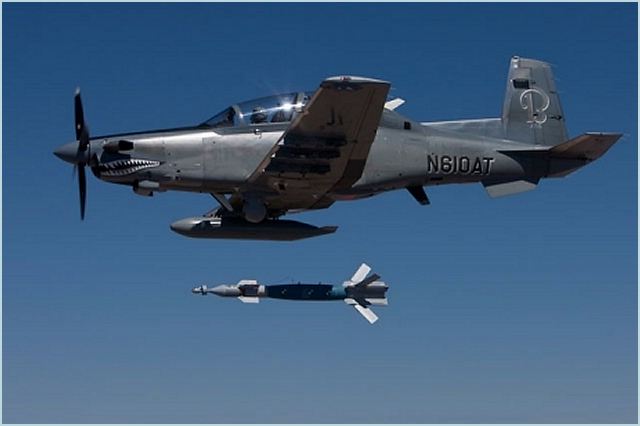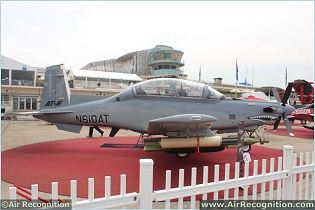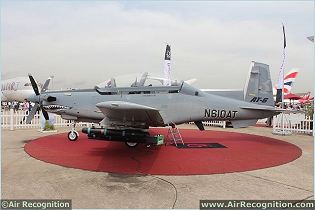AT-6C Texan II
| a | ||||||||||||||||||||||
|
AT-6C Texan II light attack and reconnaissance aircraft
|
||||||||||||||||||||||
 |
||||||||||||||||||||||
|
|
||||||||||||||||||||||
|
As multi-role aircraft, the AT-6C Texan II is capable of meeting a wide spectrum of warfighter missions including: close air support, forward air control, combat search and rescue, armed reconnaissance and airborne interdiction. The AT-6 fills a number of peacetime roles, including maritime patrol, disaster relief and border security. The light attack version of the AT-6C is designed by a team led by Hawker Beechcraft and Lockheed Martin, the AT-6C recently completed another successful test, dropping precision-guided munitions for the first time as part of an ongoing demonstration by the Air National Guard Air Force Reserve Test Center (AATC). The AT-6 is the only Light Attack Armed Reconnaissance aircraft with proven interoperability in U.S. and NATO command and control environments. While it routinely operates in interoperable missions, it also has the autonomous capability to detect, identify and prosecute targets. The AT-6 prototype completed its first flight in September 2009, and entered the next phase of flight testing. The second AT-6 prototype, which is powered by a Pratt & Whitney Canada PT6A-68D engine completed its maiden flight on 5 April 2010. Each engine can produce 1,600shp (1,193kW) of power. |
||||||||||||||||||||||
| Main Variants | ||||||||||||||||||||||
|
- T-6A Texan II: Standard version for the USAF, USN, and Hellenic Air Force (25).
- T-6A NTA Texan II: Armed version of the T-6A for the HAF (20). T-6A NTA has the capability to carry rocket pods, gun pods, external fuel tanks, and bombs. - T-6B Texan II: Upgraded version of the T-6A with a digital glass cockpit that includes a Head-Up Display (HUD), six multi-function displays (MFD) and Hands On Throttle And Stick (HOTAS),[21] used at Naval Air Station Whiting Field. - AT-6B Texan II: Armed version of the T-6B for primary weapons training or light attack roles. It has the same digital cockpit, but upgraded to include datalink and integrated electro-optical sensors along with several weapons configurations. Engine power is increased to 1,600shp (1193 kW) with the Pratt & Whitney Canada PT6-68D engine, and the structure is reinforced. - AT-6C Texan II: Upgraded version of the T-6B with wing hard points, and intelligence, surveillance, reconnaissance capabilities. - CT-156 Harvard II: Version of the T-6A for NTFC with the Canadian Forces.[10] Nearly identical to standard USAF and USN in terms of avionics, cockpit layout, and performance. |
||||||||||||||||||||||
| Technical Data | ||||||||||||||||||||||
| Design | ||||||||||||||||||||||
|
The AT-6C is an armed version of the T-6 which is a development of the Pilatus PC-9, modified significantly by Beechcraft in order to enter the Joint Primary Aircraft Training System (JPATS) competition in the 1990s. A similar arrangement between Pilatus and British Aerospace had also been in place for a Royal Air Force competition in the 1980s, although this competition selected the Short Tucano. The aircraft was designated under the 1962 United States Tri-Service aircraft designation system and named for the decades-earlier T-6 Texan.
|
||||||||||||||||||||||
| Avionics and equipment | ||||||||||||||||||||||
|
The AT-6B fully integrated avionics system uses two powerful mission computers to control weapons deliveries and other mission related functions. Integrated navigation and mission data is displayed on the large, 25° total field of view (TFOV) head-up display (HUD) and on three high-fidelity 5in×7in multifunction displays (MFDs). The up-front control panel (UFCP) provides central control of navigation, air-to-air and air-to-ground master modes from the front and rear cockpits. It also supports radio communication and navigation aid management, weapon selection and programming, waypoint management and designation of markpoints. The primary flight display (PFD) provides the controls and displays required to manage and present primary flight information to the pilots including attitude, airspeed, altitude and flight path direction. The tactical situation display (TSD) enhances situational awareness by presenting a scalable plan view of the key elements required for terminal, en route, area and tactical navigation. The colour digital moving map display (MAP) presents the aircraft's relationship to the outside physical environment. It also provides key flight, navigation and tactical display of information to give the crew a high degree of situational awareness flights. An engine instrument and crew alerting system (EICAS) provides aircraft and engine system information including status of the engine, propeller, hydraulic, fuel, trim and flap. The avionics suite also includes a data transfer system for navigation and operation planning and a digital video recorder for mission debrief.
|
||||||||||||||||||||||
| Propulsion | ||||||||||||||||||||||
|
The AT-6C Texan II has a Pratt & Whitney Canada PT6A-68 turbo-prop engine that delivers 1,100 horsepower. Because of its excellent thrust-to-weight ratio, the aircraft can perform an initial climb of 3,100 feet (944.8 meters) per minute and can reach 18,000 feet (5,486.4 meters) in less than six minutes.
|
||||||||||||||||||||||
| Armament | ||||||||||||||||||||||
|
The AT-6C Texan II sets the standard by employing a broad range of weapons that no other light attack aircraft can match. There are six wing-mounted hardpoints for stores. The AT-6 has demonstrated high-end net-centric and light attack capabilities, as well as full compatibility with U.S. and NATO Joint Terminal Attack Controller systems designed to meet the spectrum of needs for the dynamic Light Attack mission. The AT-6C is capable of operating over 30 weapons and fuel configurations. That gives the war fighter the flexibility to tailor the weapons configurations to efficiently and effectively complete the mission. It is also the first fixed-wing aircraft to successfully employ 2.75" laser guide rockets. |
||||||||||||||||||||||
| Specifications | ||||||||||||||||||||||
|
||||||||||||||||||||||
 |
||||||||||||||||||||||
|
||||||||||||||||||||||
| {gallery}north_america/united-states/other_aircraft/at-6c_texan_ii/pictures{/gallery} | ||||||||||||||||||||||






























